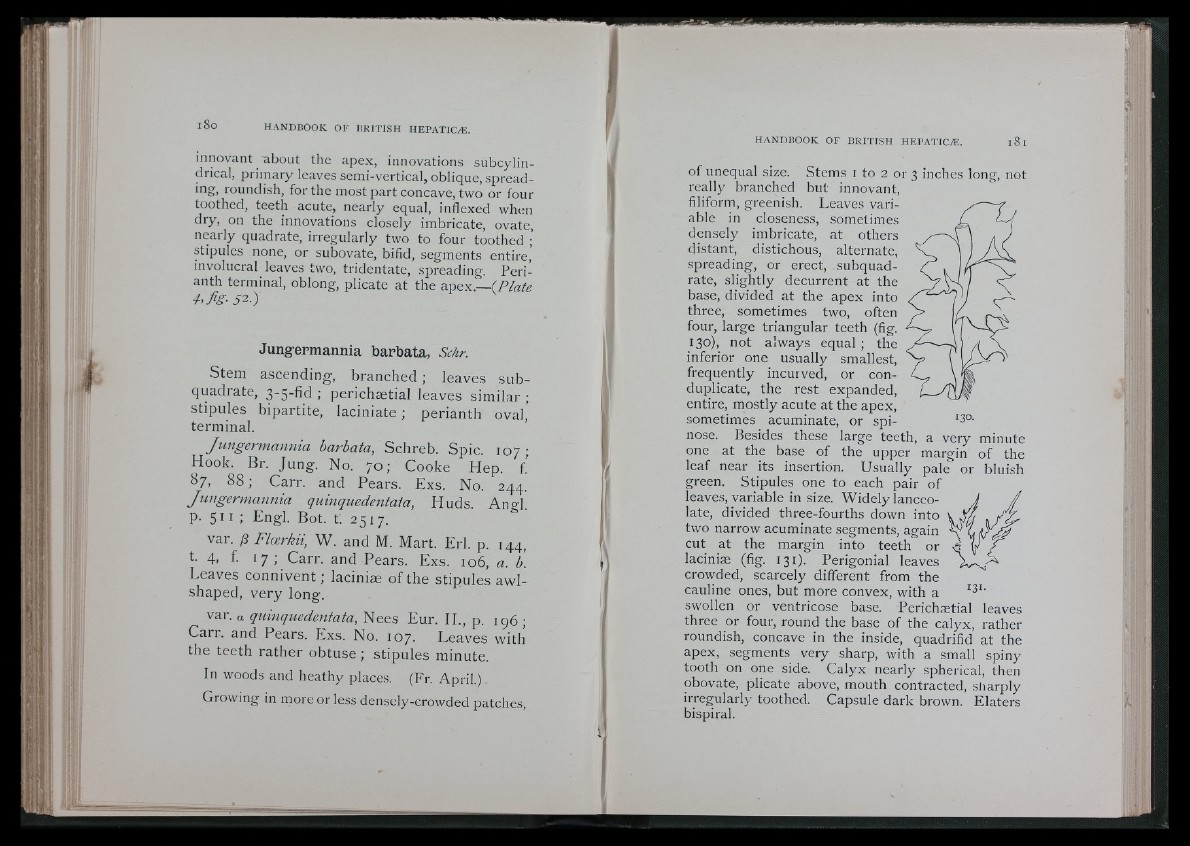
HANDBOOK OF BRITISH HEPATICÆ. l 8 I
WtV
I 11* J '
ii
\M
;i ‘
fr.
Ï
'■A
innovant about the apex, innovations subcylin-
dncal, primary leaves semi-vertical, oblique, spreading,
roundish, for the most part concave, two or four
toothed, teeth acute, nearly equal, inflexed when
dry, on the innovations closely imbricate, ovate,
nearly quadrate, irregularly two to four tootlied ;
stipules none, or subovate, bifid, segments entire,’
involucral leaves two, tridentate, spreading. Perianth
terminal, oblong, plicate at the apex.— (Plate
P fig - 52.)
Jungermannia barbata, Schr.
Stem ascending, branched ; leaves su b quadrate,
3-5-fid ; perichaetial leaves similar ;
st ipules bipartite, lac iniate ; perianth oval,’
terminal.
Jungermannia barbata, Schreb. Spie. 10 7 ;
Hook. Br. Jung. No. 70 ; Cooke Hep. Î.
87» 88; Carr, and Pears. Exs. No. 244.
Jungermannia quinquedentaia, Huds. Angl,
p. 5 1 1 ; Engl. Bot. t. 2517.
var. p Floerkii, W. and M. Mart. Erl. p. 144,
L 4 > f- 17 ; Carr, and Pears. Exs. 106, a. b.
Lea v e s connivent ; laciniæ of the st ipules awl-
shaped, v e r y long.
var. a quinquedentata, Nees Eur. II., p. 196 ;
Carr, and Pears. Exs. No. 107. Le a v e s with
the teeth rather o b tu s e ; st ipules minute.
In woods and heathy places. (Fr. April.)
Growing in more or less densely-crowded patches,
f]
of unequal size. Stems i to 2 or 3 inches long, not
really branched but innovant,
filiform, greenish. Leaves variable
130.
in closcnes-s, sometimes
densely imbricate, at others
distant, distichous, alternate,
spreading, or erect, subquadrate,
slightly decurrent at the
base, divided at the apex into
three, sometimes two, often
four, large triangular teeth (fig.
130), not always equal ; the
inferior one usually smallest,
frequently incurved, or conduplicate,
the rest expanded,
entire, mostly acute at the apex,
sometimes acuminate, or spi-
nose. Besides these large teeth, a very minute
one at the base of the upper margin of the
leaf near its insertion. Usually pale or bluish
green. Stipules one to each pair of
leaves, variable in size. Widely lanceolate,
divided three-fourths down into
two narrow acuminate segments, again
cut at the margin into teeth or ri / ,
laciniæ (fig. 131). Perigonial leaves
crowded, scarcely different from the
cauline ones, but more convex, with a
swollen or ventricose base. Perichætial leaves
three or four, round the base of the calyx, rather
roundish, concave in the inside, quadrifid at the
apex, segments very sharp, with a small spiny
tooth on one side. Calyx nearly spherical, then
obovate, plicate above, mouth contracted, sharply
irregularlj' toothed. Capsule dark brown. Llaters
bispiral.
1
J .